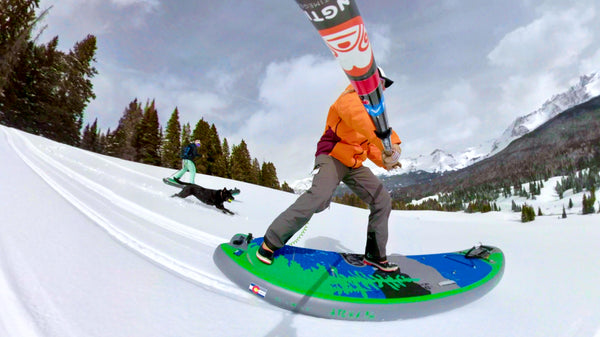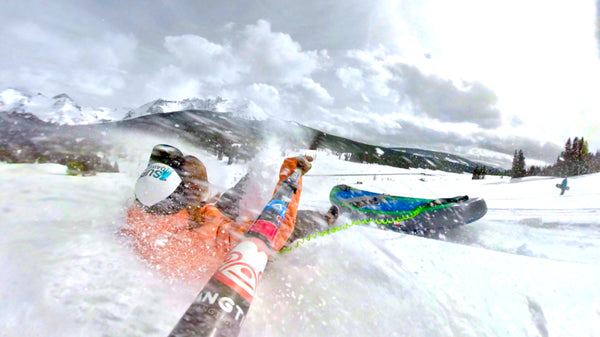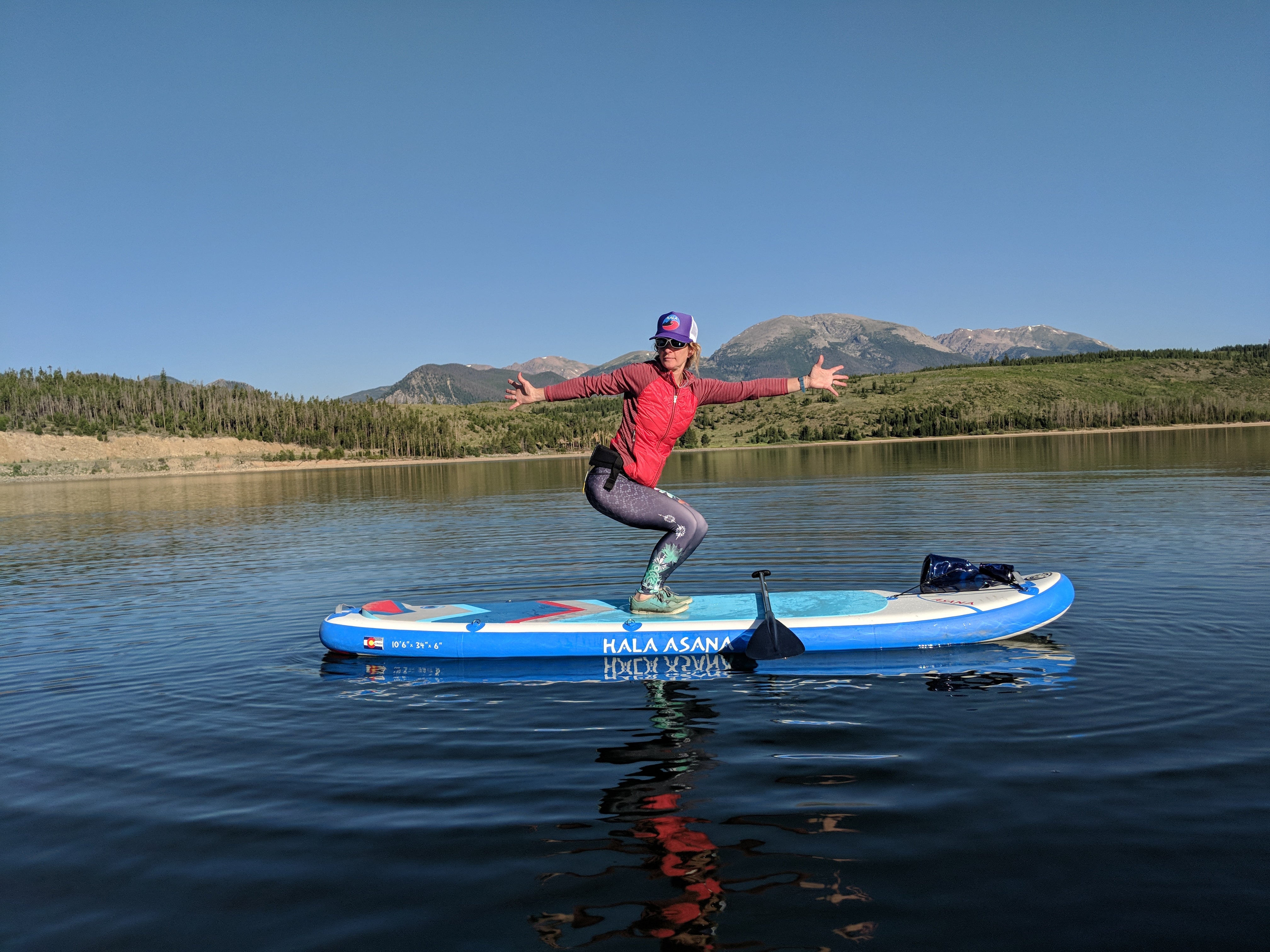
SUPing on Snow: What You Need to Know
Well folks, here we are. The ski resorts are closed despite the fact that there is still a little bit of winter left. Are you desperate to find alternative methods of having fun on the snow? The good news is, you’re in luck! Break out the board and go hit up your local sledding hill for a little snow SUP adventure.

Here is everything you need to know about stand up paddleboarding on the snow.
First, before I dive in, I have to warn, snow SUPing isn’t for the faint of heart. It requires a fair amount of physical fitness, is a kick-ass cardio workout and is one hell of an adrenaline rush! Please, if you have heart or health conditions, consult your physician before partaking in this physically demanding activity.
April 10, 2020 Note: With consideration to COVID-19, we encourage SUPers to #stayathome and follow safe recreation guidelines. Hala HQ will not be testing these tips until Winter 20/21.
Let’s start with the basic gear you will need to in order to SUP on snow:
- Stand up paddleboard. I like to use my Atcha 86 or my Rado board.
- Paddle to help control steering and speed
- Appropriate footwear
- Leash
Most basic snow boots work best. Anything too stiff like a snowboard boot will throw off your balance and footing, and prevent you from being able to bend and control your board. You’ll want boots with good traction, for not only hiking purposes but snow on a paddleboard is slippery. And you’ll want them to be warm, because...snow.
Leashes can be used to help haul your board uphill. A leash also keeps your board from taking off if and when you fall. If your slope fizzles out into a flat area, ends in shrubs or another hill and isn’t going to slide too far, you’re probably fine. If you fall or bail prematurely, however, the board will keep going and you will end up chasing after it, which is not a lot of fun after you’ve spent all that work hiking up. Or if you’re worried about the board going somewhere you don’t want it to, you will want to keep the board attached to you.

Where to snow SUP?
What is the perfect slope? This was probably the hardest thing to find. Now, I’ve only tried snow SUPing on powder and haven’t attempted it on hard-packed snow. I’ve also only ever ridden Hala Gear’s inflatable SUP boards and haven’t tried snow SUPing on hard boards. To learn more about the differences between inflatables and hardboards, check out this post.
What my friends and I have discovered is that if a slope was too steep, it is hard to get up and stay on the board. Paddleboards get going pretty fast on snow, and speed combined with the slippery aspect made it difficult to stay on. In regards to slope angle, safety is #1! It’s important to remember, if you’re in the backcountry, stay away from avalanche-prone terrain and slopes that are 25 degrees or more.
Visa versa, slopes that aren’t steep enough make it impossible to get moving. Though it is possible to push along with your paddle, it’s not that much fun.
Also, for the sake of not damaging you or your board, try to stick to hills that you know are covered in grass and not rocks or small shrubs.
Find a slope that is similar in angle to our favorite childhood sledding hill. Or, if you’re relating it to ski slopes, this would be your steeper green run...a 15-20 degree slope is perfect, depending on how fast you want to go.
Lastly, we discovered temperature plays a big role in whether or not your SUP board will slide. A warm, sunny day with fresh snow on a slope will cause the snow to stick to your board, preventing you from going anywhere. Go on a cooler day or wait for the temps to drop a bit and you’ll be good to slide!

Fin on or no fin?
This is a personal preference. I ride Hala Gear’s river boards which happen to have removable fins. I run my boards with the Low Pro River fins along with Hala’s StompBox center fin, because it’s retractable. What I’ve found is that without fins, I go quite a bit faster, and with fins, I have more control over speed and going straight. If you must/choose to use fins, only do so if the snow is soft and deep enough otherwise you risk damage to your board.
 What about wearing a helmet?
What about wearing a helmet?
This, much like skiing, snowboarding and any other adrenaline sport is a personal preference. Helmets are always a great idea! Especially if you’re near trees or know there are hidden stumps or rocks below. When you are on the river, however, Hala highly recommends wearing a helmet because rocks hurt.

When to bail, and how?
Knowing when to bail is a personal preference that depends on the slope, speed, and obstacles. Are there roads you could slide out on? Trees, houses, cars, etc…? How you bail is really up to you, but I tend to fall/bail like how you’re supposed to fall into a river: on my butt/back, as flat as possible so my feet don’t hit anything under the snow.
More tips:
- Be prepared for a workout! Like, a serious one. Take water and snacks with you as you’ll likely be thirsty and hungry when you get to the top of the hill.
- The deeper the snow and the longer the hill, the harder the hike, but the more worth it the run will be.
- Also, it’s easier to keep your grip on the board if you stand with one foot bracing on the rear deck pad kick (like river surfing) and the other right up against the center handle to keep your foot from sliding forward.
- Really, it’s just like sledding! Think of stand up paddleboarding on snow as the most fun, oversized sled you’ve ever ridden! Why isn’t everybody doing it?
- Oh yeah, it’s more fun with friends..and dogs!

Nola Svoboda is a team rider for Hala Gear.

 What about wearing a helmet?
What about wearing a helmet?
Leave a comment
This site is protected by hCaptcha and the hCaptcha Privacy Policy and Terms of Service apply.